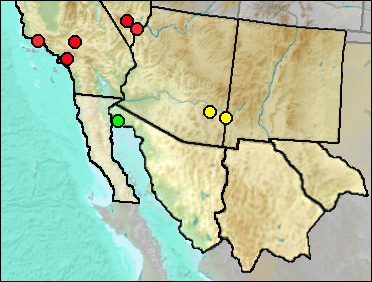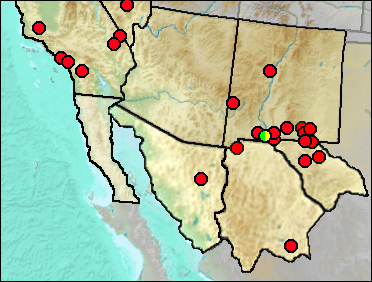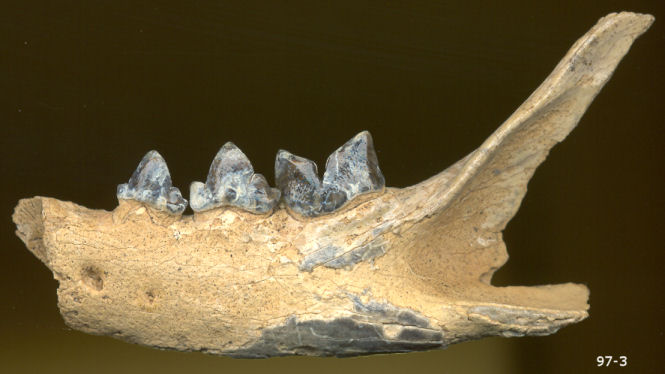Class Mammalia
Order Carnivora
Family Felidae

A distal humerus from Virden is tentatively assigned to Lynx, closely resembling that of L. rufus except for somewhat larger size (Morgan et al. 2008).
Wilson's Rampart Cave record almost certainly is Lynx rufus, but he considered the specimen unidentifiable beyond the generic level (Wilson 1942).
Sites.
Late Blancan: 111 Ranch (Morgan and White 2005); Virden (Morgan et al. 2008).
?Irvingtonian/Rancholabrean: Emery Borrow Pit (Jefferson 1991b).
Irvingtonian: El Golfo (Croxen et al. 2007: gen. cf.).
Rancholabrean: Tule Springs (Springer et al. 2005: ?).
Wisconsin: Carpinteria (Wilson 1933).
Mid/Late Wisconsin: Rampart Cave (Wilson 1942).
Late Wisconsin: Gypsum Cave (Jefferson et al. 2015).
Late Wisconsin/Holocene: Schuiling Cave (Jefferson 1991b).
Literature.
Croxen et al. 2007; Jefferson et al. 2015; Morgan and Harris 2015; Morgan and White 2005; Morgan et al. 2008; Springer et al. 2005; Wilson 1933, 1942.

Synonyms. Felis rufus.
Bobcats are common throughout our region in virtually all types of habitat from low desert to montane forest. Rodents and lagomorphs make up most of the diet, though artiodactyls, and especially their young, may be taken on occasion. This commonness is reflected in the number of sites with Bobcat remains.
The lower jaw shown in Fig. 1 was characterized by Vanderhill (1986:138) as "morphologically indistinguishable from modern Lynx rufus, although it is somewhat larger...." Kurtén and Anderson (1980) note that Irvingtonian bobcats are generally somewhat larger than those of later times.
A second specimen was tentatively identified by Vanderhill as an aberrant Bobcat, though with reluctance. The element is that of a young animal, with p3 and p4 visible within the alveoli but would not have been erupted at the time of death. The m1 appears to be a bit longer than in a series of L. rufus and L. canadensis and has two lingual accessory cusps (Fig. 2) apparently not noted in the literature (Vanderhill 1986). Although not mentioned by Vanderhill, the alveolus for the canine suggests the tooth is larger than typical for L. rufus.

Fig. 1. Lateral view of a partial left lower jaw of Lynx rufus, apparently from the late Blancan of southern Doña Ana Co., New Mexico.

Fig. 2. Dorsal view of a partial left lower jaw of a felid considered tentatively by Vanderhill (1986) as an aberrant bobcat. Note the two accessory cusps on m1.
Sites.
Late Blancan: La Union (Morgan and Lucas 2003: ?).
Early Irvingtonian: Adobe Ranch (Morgan and Lucas 2003).
Rancholabrean: Anthony Gap Cave (UTEP).
Rancholabrean/?Early Holocene: Mitchell Caverns (Jefferson 1991b).
Early/Early-Mid Wisconsin: Lost Valley (Harris 1993c); Rm Vanishing Floor (Harris 1993c).
Mid Wisconsin: McKittrick (Schultz 1937); Pendejo Cave (Harris 2003); Térapa (Mead et al. 2006); U-Bar Cave (Harris 1987).
Mid/Late Wisconsin: Dark Canyon Cave (Tebedge 1988); Diamond Valley (Springer et al. 2009); Hampton Court (Harris 1993c); NW Talus Slope (Harris 1993c); Pendejo Cave (Harris 1993c); Pintwater Cave (Jefferson et al. 2015); Rancho La Brea (Stock and Harris 19920.
Mid Wisconsin-Holocene: Shelter Cave (Harris 1993c).
Mid/Late Wisconsin/Holocene: Jimenez Cave (Messing 1986); Sierra Diablo Cave (UTEP).
Late Wisconsin: Algerita Blossom Cave (Harris 1993c); Big Manhole Cave (Harris 1993c); Dust Cave (Harris and Hearst 2012); Human Corridor (Harris 1993c); La Mirada (Jefferson 1991b); Kentucky Club Room (Harris 1993c); Muskox Cave (Logan 1981); Park Place, Irvine (Jefferson 2014); U-Bar Cave 13-14 ka (Harris 1989); U-Bar Cave 14-15 ka (Harris 1989); U-Bar Cave 15-18 ka (Harris 1989); U-Bar Cave 18-20 ka (Harris 1989).
Late Wisconsin/Holocene: Aden Fumarole (UTEP); Balcony Room (Harris 1993c); Burnet Cave (Schultz and Howard 1935); Conkling Cavern (Conkling 1932); Fowlkes Cave (Dalquest and Stangl 1984b); Isleta Cave No. 1 (Harris 1993c); Isleta Cave No. 2 (Harris 1993c); Kokoweef Cave (Reynolds, Reynolds, et al. 1991); Pendejo Cave (Harris 2003); Williams Cave (Ayer 1936: cf.).
Literature.
Ayer 1936; Conkling 1932; Dalquest and Stangl 1984b; Harris 1987, 1989, 1993c, 2003; Harris and Hearst 2012; Jefferson 1991b, 2014; Jefferson et al. 2015; Logan 1981; Messing 1986; Morgan and Lucas 2003; Reynolds, Reynolds, et al. 1991; Schultz 1937; Schultz and Howard 1935; Springer et al. 2009; Stock and Harris 1992; Tebedge 1988; Vanderhill 1986.
Last Update: 1 Feb 2016